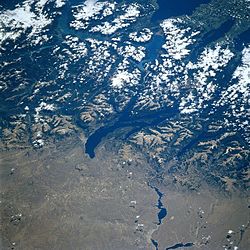- Nahuel Huapi Lake
-
Nahuel Huapi Lake 
Location Patagonia Coordinates 41°05′25″S 71°20′08″W / 41.09028°S 71.33556°WCoordinates: 41°05′25″S 71°20′08″W / 41.09028°S 71.33556°W Primary outflows Limay River Basin countries Argentina Max. width 6.3 mi (10.2 km) Surface area 205 sq mi (530 km2) Average depth 515 ft (157 m) Max. depth 1,437 ft (438 m) deeper places might exist Shore length1 222 mi (357 km) Surface elevation 2,510 ft (770 m) Islands Isla Victoria Settlements San Carlos de Bariloche, Villa La Angostura 1 Shore length is not a well-defined measure. Nahuel Huapi Lake (Spanish: "Lago Nahuel Huapí") is a lake in the lake region of northern Patagonia between the provinces of Río Negro and Neuquén, in Argentina. The lake depression consists of several glacial valleys carved out along faults and Miocene valleys that were later dammed by moraines.
Nahuel Huapi lake, located within the Nahuel Huapi National Park, has a surface of 529 km2 (204 sq mi), rests 2,510 feet (770 m) over the sea level, and has a maximum measured depth (as of 2007) of 1,437 feet (438 m).
The June 2011 eruption of the Puyehue-Cordón Caulle volcanic complex, in neighboring Chile, caused parts of the lake's surface to be blanketed in volcanic ash. [1]
Contents
Geography
Its seven branches are named Blest (36 km²), Huemul (21.5 km²), de la Tristeza (18.5 km²), Campanario (7.9 km²) , Machete, del Rincón and Última Esperanza. It is connected to other smaller lakes such as Gutiérrez, Moreno, Espejo and Correntoso. The deep-blue waters hold a number of islands, most notably Isla Victoria with 31 km². The name of the lake derives from the toponymy of this island in Mapudungun (Mapuche language): "Island of the Jaguar (or Puma)", from nahuel, "puma (or jaguar)", and huapí, "island". There is, however, more to the word "Nahuel" - it signifies "a man who by sorcery has been transformed to a puma" (or jaguar).
This breathtaking lake harbors several species of trout including rainbow trout, brown trout and brook trout which attract anglers from the world over. [1]
A curious fact about the lake is that, despite being nowhere near any ocean and being at high altitude, it is also home for Kelp Gull and the Blue Eyed Cormorant (Phalacrocorax atriceps), otherwise strictly marine birds. [2] [3] [4]
The lake’s crystal clear waters are very susceptible to climate changes and have an average surface temperature of 45 °F (7 °C), this makes it both beautiful and treacherous. Hypothermia is one of the risks bathers must undertake. Kayaking is a popular sport on this and adjacent lakes. The lake is also the starting point of the Limay River.
Nahuelito
Main article: NahuelitoAt the beginning of the 20th century, and following an old aboriginal legend,[citation needed] the rumor of a giant creature living in the deep waters of the lake took up. The creature is known locally as Nahuelito. Reported sightings of it predate Nessie and The Lost World (Arthur Conan Doyle). [5]
Local aborigines (Mapuche) called another creature el Cuero (leather) for its smooth skin. The neighboring lake Lago Lácar, has also been the site for accounts of another creature, more consistent with a plesiosaur, with aborigines describing it as a sea-cow with teeth all around it.
Members of the Buenos Aires Zoo visited the lake in 1922 trying to corroborate the reports of sightings of the prehistoric animal, but found no evidence to support the theory of such a creature.
See also
- Huemul Project, the Argentine secret research project on nuclear fusion on the Huemul Island.
- Limay River, a major river of the region that is born in the lake.
External links
- World Lake's Database
- Nasa's Satellite View
- Nahuel Huapi Fauna
- Blue Eyed Cormorant
- Bariloche Tourism
- Reevaluation of Cheek Patterns of Juvenal-Plumaged Blue-Eyed and King Shags
- Nahuelito, Patagonian Lake Monster
- Satelital image of the Nahuel Huapi lake(2369x2328 pixels)
References
- ^ "Chilean volcano fills lake with ash". The Daily Telegraph (London). 16 June 2011. http://www.telegraph.co.uk/earth/earthvideo/8580835/Chilean-volcano-fills-lake-with-ash.html.
Categories:- Lakes of Argentina
- Geography of Río Negro Province
- Geography of Neuquén Province
- Glacial lakes of Argentina
Wikimedia Foundation. 2010.


